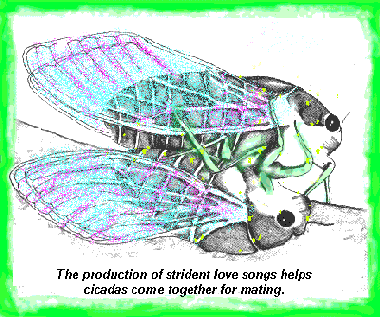

2. Australian cicadas are the loudest insects in the world.
3. There are just under 2000 species of cicada around the world. In Australia around 220 species have been identified, most of which belong to the one large Cicadidae family.
4. Another little-known fact is that cicadas suffer from insect VD - entomopathogenic fungi attack the terminal portion of their abdominal cavity and genitalia - a cicada venereal disease - it is a fungus unique to cicadas and it usually makes their tail ends drop off.
5. They are quite good eating and taste quite pleasant - especially roasted - The female cicada is usually best because they are the most meaty. First, pull the wings off and then throw them onto hot coals for about a minute. Turn them over once or twice and they’re ready to eat. Rather than crunchy, they actually are remarkably soft. Their taste is not very strong and is probably closer to chicken than anything else.
6. Green Grocers can generate noise louder than 120dB - equivalent to that of a canon going off or standing next to a speeding train.
7. Only the male sings as a mating ritual to attract the females and different species have different songs so they don’t attract the wrong females.
8. Cicadas are different to all other insects in that they actually have a musical drum in their abdomen. The organs that produce sound are the tymbals – a pair of ribbed membranes at the base of the abdomen. The inside of the male abdomen is substantially hollow to amplify the sound as it resonates at the frequency of the call.
9. The loud noise produced by some cicadas actually repels birds. The males of many cicada species tend to group together when calling which increases the total volume of noise and reduces the chances of being eaten by birds.
10. In addition to the calling or mating song, many species also possess a distress song, usually a broken and erratic noise emitted when an individual is captured. A number of species also have a courtship song, which is usually a quiet call produced only after a female has been attracted nearby using the calling song.
11. There are three distinct stages in the life cycle of a cicada – egg, nymph and adult.
12. After mating, the female will lay several hundred eggs. She makes a little slit in the bark of the branch as she walks along and pushes the eggs down through her long tail. She deposits 12 or so into each slit and then moves on a few millimetres to make another slit for more eggs, and so on, until all the eggs have been laid. The eggs stay in the slits in the bark for many weeks and then hatch into a miniature cicada called a nymph. Because they are so small they can fall down to the ground without injuring themselves and seek shelter underneath the leaf litter. They search for cracks and burrow down between 10cm and 40cm using their large forelegs to shovel soil around. It’s here, underground, that Cicadas spend most of their life. The cicada nymph feeds by piercing small tree roots with its needle-like rostrum and sucking up sap. When the sap runs out, it tunnels around to find a new root to feed from. While living and feeding underground they continue growing, periodically shedding their skin, until they reach maturity. When they emerge from the ground they live for varying periods of time, from a few days to a couple of months, depending on the species. The majority live for around two to four weeks during which time they mate and lay eggs and the cycle starts again.

13. Traditional Chinese herbal medicine made use of cicadas for a variety of medical purposes. They believed they could do all sorts of things for you if you ate them or crushed them up to make a poultice. Cicadas were used as a diuretic by peasants in Provênce and as a cure for earache in China and Japan.
14. To the ancient Greeks the cicada symbolised resurrection, rebirth and
immortality and is mentioned as being sacred to the ancient Greek sun god
Apollo.
Skewered Cicadas - Famous dish in Shanghai
INGREDIENTS:
250g cicadas, anises, mashed garlic, celery, turnip, salt, gourmet powder, rice
wine
RECIPE:
Boil the cicadas, anises, salt, gourmet powder, rice wine for 5 minutes, then
take the cicadas out of the pot.
Saute the mashed garlic, then put in water, rice wine, gourmet powder to braise them.
Deep-fry the cicadas until they look golden, then take them out and skewer them with bamboo picks, fry them in the pot for another minute, shape them with turnip, celery like cicadas getting out of mud.
Finally put them on a heated
iron plate and pour the mashed garlic juice on them.

Australian Animals - Wildlife Index


Page background created by
